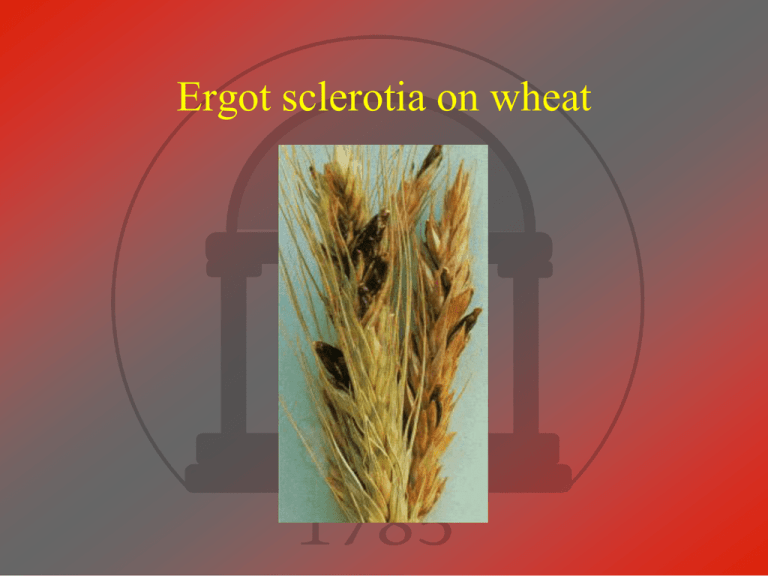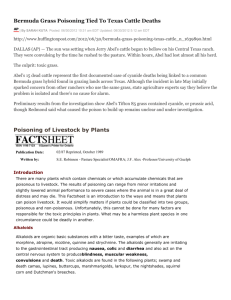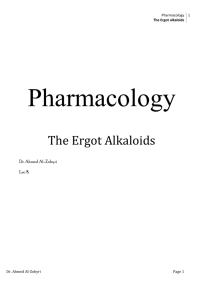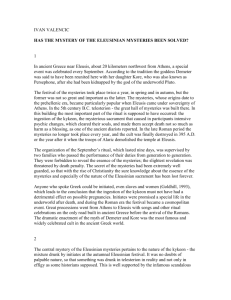Ergot sclerotia on wheat
advertisement

Ergot sclerotia on wheat History of ergotism Rye was not cultivated until the 5th century AD. Ergot prefers to infect rye flowers. Ergotism was widespread during the Middle Ages, since rye grows easily even in poor soils. The first historically documented outbreak of ergotism was in 857 AD in the Rhine valley. Ergot grows best in a damp climate like that in Germany or Northern France. Ergot was so common that it was called “Holy Fire”. History of ergotism An order of monks was founded just to take care of ergotism sufferers, the Order of St. Anthony's. Ergotism became known at “St. Anthony's Fire”. Dr. Thuiller in 1670 was the first to recognize that the disease was caused by ergot. Dr. Louis Tulasne showed in 1853 that ergot was a fungus that infected rye and caused the disease. The symptoms of ergotism Convulsive ergotism results in severe twisting of the body and neck in pain, together with shaking and trembling. Gangrenous ergotism causes constriction of the blood flow in the extremities, which results in burning pain. Fingers and toes die and they can even break off or drop off. Both convulsive and gangrenous ergotism can be associated with vivid hallucinations, physical and mental excitement, and disorientation. All forms of ergotism have a relatively high mortality rate. The life cycle of ergot After the winter, the sclerotia sprout to produce mushroom-shaped stroma, which release spores, in the spring. These spores infect rye flowers to form asexual spore-forming spacelia, which in turn release spores. Bees then transfer the spores to other rye flowers, and these spores grow eventually to reform the sclerotia. This is an example of “alternation of generations”. Ergotism and the Salem Witch Trials Ergotism may have caused the Salem Witch Trials—Linda Caporeal. In December 1691, a number of girls in Salem, including the daughter of the minister, Samuel Parris, developed unusual behaviors, including convulsions, odd postures and strange gestures. They accused several women of being witches. The girls did not improve, and eventually more than 100 people were accused and imprisoned. Twenty people were executed as witches. The remainder were eventually released. Ergotism and the Salem Witch Trials The summer of 1691 was especially wet. Most people in Salem grew rye as a staple crop. The symptoms developed as soon as the rye crop was used. The affected girls were from families who had the wettest fields. As soon as a new rye crop was used, the symptoms disappeared. The last outbreak of ergotism The most recent outbreak of ergotism may have occurred at Pont-St.-Esprit, France in 1951. Hundreds of townspeople suddenly developed strange symptoms, including intense pain, complaints of feeling cold, and dementia, accompanied by vivid hallucinations. The doctors found that wheat bread was the common food item. It may have been mixed with contaminated rye flour. It has been recently suggested that the CIA poisoned the townspeople with LSD. Pont-St.-Esprit Animals also get ergotism Tall fescue, a pasture grass for grazing cattle, can be infested with a fungal endophyte. Animals that eat infected grass can develop vasoconstriction and gangrene in ears and hooves. Afflicted animals do not eat and gain weight, causing economic loss to farmers. Chemistry of ergot Chemists were very interested in the components of ergot. Ergotamine was isolated in 1918 by Arthur Stoll. Ergotamine was found to be a derivative of lysergic acid (lysis ergot ic acid) by Jacobs and Craig at Rockefeller. Albert Hoffman started working on lysergic acid derivatives at Sandoz in the 1930's. He prepared ergonovine as a hemostatic drug for obstetrics. Chemistry of ergot O N N O HN O O CH3 OH N CH3 H N H Ergotamine O N CH3 H N H D-lysergic acid Chemistry of ergot Hoffman prepared a series of lysergic acid derivatives to evaluate their activity. Lysergic acid diethylamide (Lyserg-SaureDiäthylamid in German, or LSD) was the 25th derivative. In 1943, after handling LSD-25, Hoffman noticed he felt odd for several hours. The next day, he purposefully ingested 250 μg of LSD to determine if the compound caused the effects. Chemistry of ergot Hoffman felt very strong effects and decided to ride his bicycle home. He called the doctor, thinking he was dying. The doctor found only that his pupils were dilated but he was otherwise normal. After a few hours, the effects subsided. Sandoz began to market LSD as an aid for psychotherapy. In 1965, they took it off the market due to negative publicity. Chemistry of ergot HN O OH N CH3 H N H Ergonovine NH2 O N N CH3 H N H LSA-11 O N CH3 H N H LSD-25 Ergot and headaches Hoffman prepared other lysergic acid derivatives with activity against migraine headaches. Methysergide is a serotonin antagonist which is prophylactic for migraines. Dihydroergotamine can be taken after a migraine has started. LSD has also been reported by users to relieve migraine and cluster headaches, and is under investigation now. Ergot and headaches HN O OH HN N CH 3 H N H O OH N CH 3 H N CH3 Methergine Methysergide Triptans for headache treatment Serotonin antagonists are useful to treat migraine headaches. A class of serotonin antagonists has been designed to treat migraines—triptans. Sumatriptan (Imitrex) was the first triptan to be developed. Triptans N NH O H N N O S O O S H2N O N H Sumatriptan (Imitrex) N H Eletriptan (Relpax) N H Frovatriptan (Frova)











